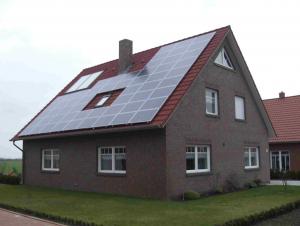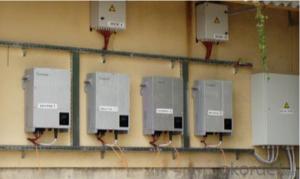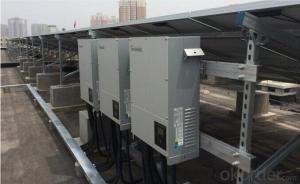Grid Connected Solar Inverter 4000-6000UE
- Loading Port:
- Shekou
- Payment Terms:
- TT or LC
- Min Order Qty:
- 10 pc
- Supply Capability:
- 10000 pc/month
OKorder Service Pledge
OKorder Financial Service
You Might Also Like
Grid Connected Solar Inverter 4000-6000UE
Tri-power excellent inverter for small residential and commercial projects
DC input voltage up to 800V
Maximum efficiency of 97.9%
Internal DC switch
Transformerless
Compact design
Multi MPP controller
MTL-string
Bluetooth/ RF technology/ WiFi
Sound control
Easy installation
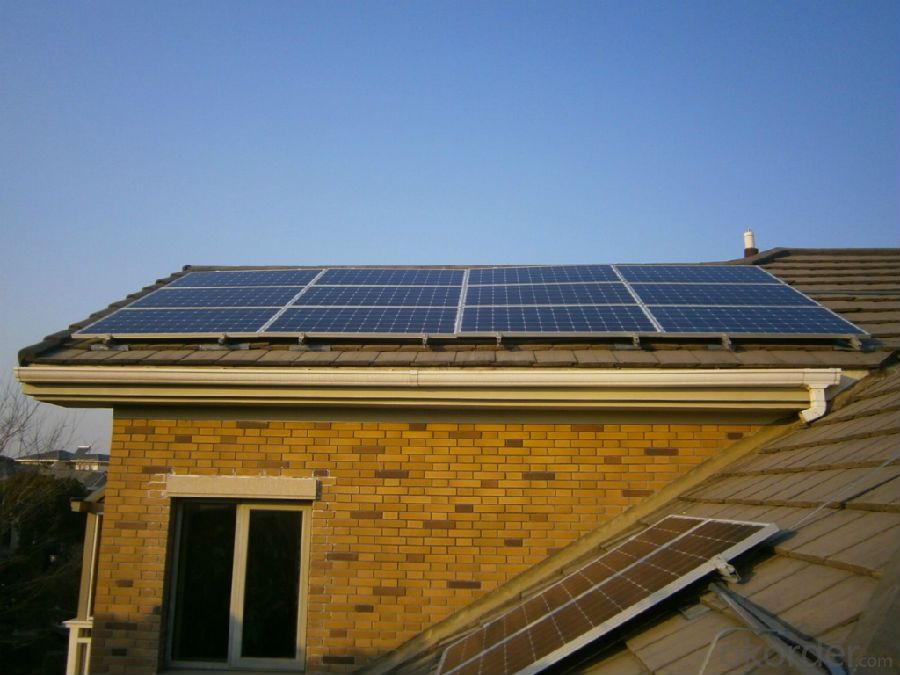
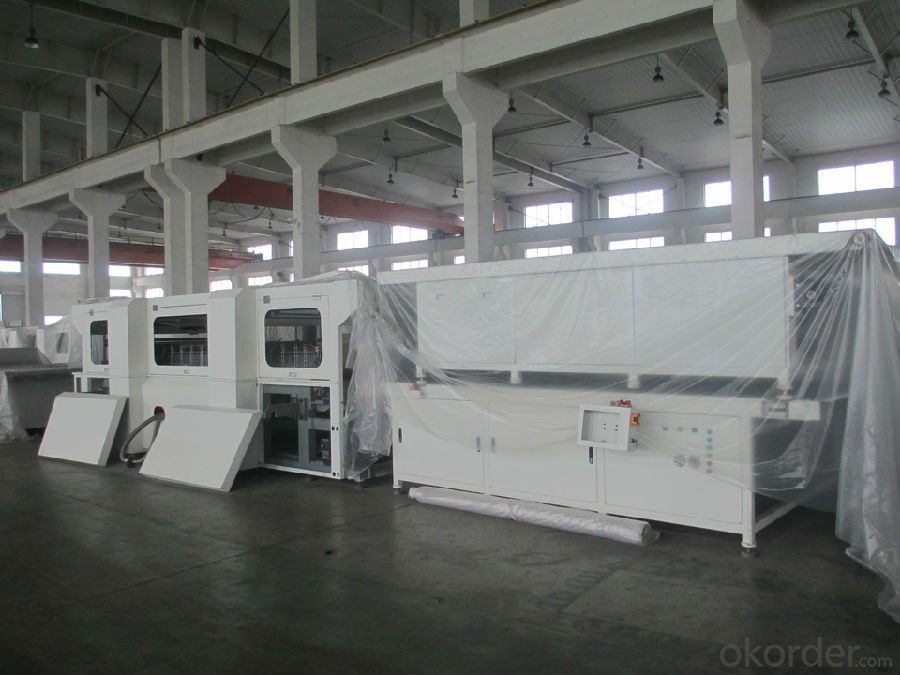
4000UE | 5000UE | 6000UE | |
| Inputdata | |||
| Max.DCpower | 4200W | 5200W | 6300W |
| Max. DC voltage | 800V | 800V | 800V |
| Start Voltage | 150V | 150V | 150V |
| PV voltage range | 140V-800V | 140V-800V | 140V-800V |
| MPP voltage range /Nominal voltage | 200V-800V/ 580V | 200V-800V/ 580V | 200V-800V/ 580V |
| Full load DC voltage range | 250V-750V | 300V-750V | 350V-750V |
| Max. input current / per string | 9A/9A | 9A/9A | 10A/10A |
| Number of independent MPP trackers/strings per MPP tracker | 2/1 | 2/1 | 2/1 |
Output (AC) |
| Rated AC output power | 4000W | 5000W | 6000W |
| Max. AC apparent power | 4000VA | 5000VA | 6000VA |
| Max. output current | 6.4A | 7.9A | 9.3A |
| Max. short-circuit current | 20A | 20A | 20A |
| AC nominal voltage ;range | 230/400V;184-275V | 230/400V;184-275V | 230/400V;184-275V |
| AC grid frequency; range | 50Hz,60Hz; ±5Hz | 50Hz,60Hz; ±5Hz | 50Hz,60Hz; ±5Hz |
| Displacement power factor configurable | 0.9leading-0.9lagging | 0.9leading-0.9lagging | 0.9leading-0.9lagging |
| THDI | <3% | <3% | <3% |
| Grid connection type | 3/N/PE,3W+PE(opt) | 3/N/PE,3W+PE(opt) | 3/N/PE,3W+PE(opt) |
| Efficiency | |||
Max.efficiency | 97% | 97.4% | 97.5% |
| Features | |||
DC connection AC connection Display | H4/MC4(opt) Screw terminal LCD opt/opt/opt | H4/MC4(opt) Screw terminal LCD yes/yes/ opt/opt/opt yes/opt | H4/MC4(opt) Screw terminal LCD yes/yes/ opt/opt/opt yes/opt |
| Generaldata | |||
Dimensions(W/H/D) in mm | 433/566/195 | 433/566/195 31.1KG | 433/566/195 31.1KG |
| Certificates and ApprovalsCE, VDE0126-1-1, VDE-AR-N4105, IEC 62109-1/-2, C-tick, AS/NZS 3100, AS4777, EN61000-6-2 , EN61000-6-3, IEC61727, IEC62116, G83, EN50438 |
- Q:How does shading impact the performance of a solar inverter?
- Shading can significantly impact the performance of a solar inverter by reducing the overall energy production of the solar panels. When certain parts of the solar panel are shaded, it creates an imbalance in the current flow, resulting in a decrease in the energy output. This can lead to a decline in the overall efficiency and power generation of the solar inverter. To mitigate this issue, technologies like bypass diodes are used in solar panels to minimize the impact of shading and ensure optimal performance.
- Q:Can a solar inverter be used with a solar-powered water pumping system?
- Yes, a solar inverter can be used with a solar-powered water pumping system.
- Q:What is the maximum AC voltage that a solar inverter can provide?
- The maximum AC voltage that a solar inverter can provide typically depends on the specific model and its specifications. However, in general, most solar inverters are designed to produce a maximum AC voltage of around 240 volts in residential installations and up to 480 volts in commercial or utility-scale installations.
- Q:What is the difference between a string inverter and a micro inverter?
- A string inverter is a type of solar inverter that is connected to a string of solar panels, converting the DC power generated by the panels into AC power for use in the electrical grid or in a building. On the other hand, a micro inverter is a smaller inverter that is installed on each individual solar panel, converting the DC power directly at the panel level. The main difference between the two is that a string inverter handles the power conversion for multiple panels in a series, while a micro inverter handles the power conversion for each individual panel separately. This means that micro inverters offer benefits such as increased energy production, better system monitoring, and improved safety, but they also tend to be more expensive compared to string inverters.
- Q:Can a solar inverter be used in systems with different module types?
- Yes, a solar inverter can be used in systems with different module types. Solar inverters are designed to convert the direct current (DC) generated by solar panels into alternating current (AC) that can be used to power electrical devices. They are compatible with various module types, such as monocrystalline, polycrystalline, and thin-film solar panels, allowing them to be used in diverse solar energy systems.
- Q:What is the efficiency loss of a solar inverter over time?
- The efficiency loss of a solar inverter over time is typically minimal, with modern inverters designed to maintain high conversion efficiency throughout their lifespan. However, some gradual degradation may occur due to factors such as aging components or environmental factors, resulting in a slight decrease in efficiency over the years. Regular maintenance and monitoring can help mitigate potential efficiency losses and ensure optimal performance.
- Q:What are the advantages of using a three-phase solar inverter?
- The advantages of using a three-phase solar inverter include higher efficiency, improved power quality, and the ability to handle larger loads. Three-phase inverters distribute the power generated by solar panels more evenly across all three phases, resulting in balanced power output and reduced losses. This leads to increased overall system efficiency. Additionally, three-phase inverters offer better power quality, minimizing voltage fluctuations and harmonics, which can be beneficial for sensitive electronic equipment. Lastly, these inverters are capable of handling larger electrical loads, making them suitable for commercial and industrial applications.
- Q:Are solar inverters compatible with different solar panel technologies?
- Yes, solar inverters are generally compatible with different solar panel technologies. However, it is important to ensure that the inverter's specifications and capabilities align with the specific requirements of the solar panels being used. Some inverters may be optimized for certain panel technologies, so it's advisable to consult with manufacturers or experts to ensure compatibility and maximize system efficiency.
- Q:How does a solar inverter handle voltage fluctuations from the battery bank?
- A solar inverter handles voltage fluctuations from the battery bank by utilizing its built-in control mechanisms and electronics. These components monitor the voltage output of the battery bank and regulate it to ensure stable and consistent voltage levels. This helps prevent any sudden or drastic fluctuations that could potentially damage electrical equipment or disrupt the functioning of the system.
- Q:What is the role of a power control unit in a solar inverter?
- The role of a power control unit in a solar inverter is to regulate and control the flow of electricity from the solar panels to the electrical grid or to the connected load. It ensures efficient power conversion by managing voltage, current, and frequency, and provides protection against overvoltage, under voltage, and short circuits. Additionally, the power control unit may also include features like maximum power point tracking (MPPT) to optimize the energy output from the solar panels.
1. Manufacturer Overview |
|
|---|---|
| Location | |
| Year Established | |
| Annual Output Value | |
| Main Markets | |
| Company Certifications | |
2. Manufacturer Certificates |
|
|---|---|
| a) Certification Name | |
| Range | |
| Reference | |
| Validity Period | |
3. Manufacturer Capability |
|
|---|---|
| a)Trade Capacity | |
| Nearest Port | |
| Export Percentage | |
| No.of Employees in Trade Department | |
| Language Spoken: | |
| b)Factory Information | |
| Factory Size: | |
| No. of Production Lines | |
| Contract Manufacturing | |
| Product Price Range | |
Send your message to us
Grid Connected Solar Inverter 4000-6000UE
- Loading Port:
- Shekou
- Payment Terms:
- TT or LC
- Min Order Qty:
- 10 pc
- Supply Capability:
- 10000 pc/month
OKorder Service Pledge
OKorder Financial Service
Similar products
New products
Hot products
Hot Searches
Related keywords


